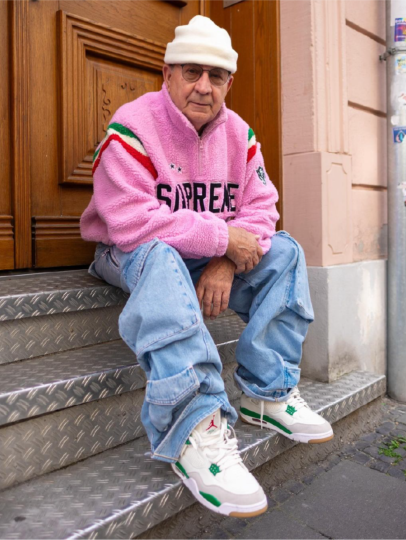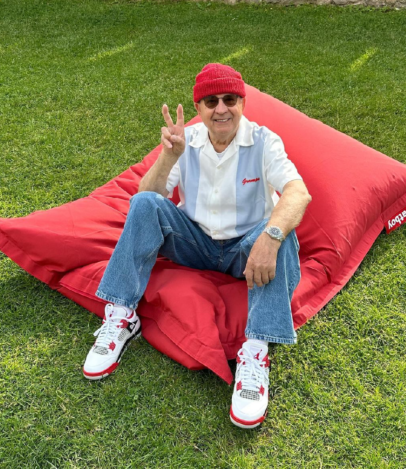There is nothing more joyful to an Indian family than its younger members embracing traditional attire on special occasions—an experience likely familiar to most, especially while visiting our grandparents. Similarly, observing your grandparents adapt from neatly ironed kurtas and crisp sarees to sporty polos and playful dresses evokes sentiments and perceptions different from what we have traditionally associated them with —from being the stalwarts of discipline and tradition to more laid-back, cooler versions of themselves. But, how can clothing contribute to the confluence of generations that stand at the end of two spectrums, varied in their beliefs and cultural traits? Beyond their basic definition as ‘items worn to cover the body, Blur the Border delves into how clothes transform into conversation facilitators. Simultaneously, we decode the term 'cool,' whose literal meaning is neither too hot nor too cold, but when applied to a person, signifies someone who is socially adept and open-minded. Recognizing the influence of cultural, social, and personal factors on this term, we delve deeper to understand how the acceptance of modern clothing plays a pivotal role in defining what it means to be cool grandparents.

Clothing and style act as mediums for visual communication, even conveying messages about a particular cultural timeline. Bearing history as a witness, clothing has evolved from being fashioned out of animal skins, leaves, bones, and shells—primarily serving as protectors—to stitched pieces of fabrics that are influenced by culture, society, personal preferences and more. Take, for instance, a traditional cotton saree, and how that immediately links us to a specific identity or a figure. According to Dress, body and Self: research in the Social Psychology of Dress, a research paper published in 2014, our behaviour toward physical objects and other people is shaped by the meaning that those things have for us. Similarly, for many - particularly the younger generation - traditional attires often carry symbols, patterns, and designs that may suggest adherence to conventional thoughts or ideas prevalent in the society, which may or may not necessarily be true.
This eventually shapes a distinct perception of our grandparents in us. We view them as earnest figures and alter our behaviour and conversations around them accordingly. According to the study The Relationship Between Clothes And First Impressions: Benefits And Adverse Effects On The Individual, factors such as clothing and style play a vital role in how impressions are formed. People take an insignificant sample of an individual and often believe it represents 100 per cent of their personality. Based on that, they decide to trust them, like them or want to maintain interaction with them.
But recall your grandfather, usually in his trusty kurta, confidently strutting in jeans and a baseball cap on his trip abroad or perhaps your grandmother donning a t-shirt and a pair of track pants for the first time– initially hesitant to wear something outside her usual dress code and colour palette, but settling in for the comfort it provided for her morning walks. As delightfully amusing as that might be, in that moment, their embrace of Western fashion became a symbol of their openness to new experiences. While wearing trendy outfits doesn't exclusively define ‘coolness’ in our grandparents–cue in taboo-busting daadis clad in traditional cotton sarees and salwar suits in iconic Bollywood movies–it certainly leaves an impact.

According to Pallak Kher, Author at Fashion is Psychology, clothing can influence how others see and interact with a person, making it a significant tool for building social connections and sending personal messages without the necessity for vocal communication. Therefore, while fashion and clothing are very telling of generational differences—for instance, viewing traditional attires as strict and disciplined and modern clothing as perceptions that shed traditional thoughts— they can also bridge the generational gap.
Take for instance a summer holiday to our grandparents’, which often meant a trip down memory lane, carefully preserved in photo albums. They would sit us down and reminisce our school plays where we played characters from their favourite mythological epics like the Mahabharata or the Ramayana. What was fascinating to them has found a parallel sense of amazement within us too, observing our grandparents interact with a stylish smartwatch or wanting to try trendy streetwear outfits on one of the shopping sprees together. Much like our grandparents' finding joy when they saw us wear costumes from popular TV shows of their time, we share a similar delight.
An additional fact to this is the current generation, especially Millennials and Gen Z, whose upbringing has been amidst significant cultural shifts. While a new wave of homegrown labels celebrating Indian crafts and silhouettes has emerged, incorporating Western sensibilities is something that has become an indispensable part of their DNA–to resonate with a broader audience. Looking at it from this perspective, assigning a ‘cool factor’ to Western clothing may also find its origins in our continous exposure to the latest Western music, movies, artists, and, consequently, fashion trends.From our earliest days in onesies and dungarees to sharing opinions about the latest runway looks, exposure to Western fashion has been an integral part of our lives. Moreover, an array of international brands at our fingertips providing access to the latest and most popular styles, we have organically woven these trends into our identities.
While we use the term cool as a casual expression, its significance within the context of modern clothing transcends a broader meaning. Observing our grandparents embrace clothing that resonates with our times could convey a powerful message. While it signifies an openness to change and a deep understanding of evolving societal norms, this choice offers opportunities for intergenerational bonding. It fosters an environment where we can explore and appreciate the similarities and differences in our respective cultural traits and shared experiences. As our grandparents impart their wisdom, the exchange becomes reciprocal, allowing us to introduce them to the nuances of a world that is more familiar to us. This mutual sharing creates a bridge between generations, enriching our relationships and cultural understanding.